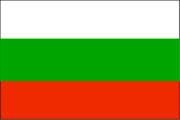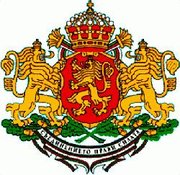Bulgarians
|
|
Template:Ethnic group The Bulgarians are a southern Slavic people generally associated with Bulgaria and the Bulgarian language. The majority of the Bulgarians nowadays live in the Republic of Bulgaria, although there are Bulgarian minorities or immigrant communities in a number of countries.
The modern Bulgarians are descendants of two peoples - the Bulgars, a nomadic people from Central Asia who settled in the Balkans in the 7th century, as well as of a number of southern Slavic tribes who had done the same a century earlier. Together the two groups formed the First Bulgarian Empire in 681. The Bulgars were later assimilated by the Slavs, who outnumbered them, but their name was retained.
To an extent the Bulgarians were also influenced by the indigenous Romanised and non-Romanised Thracian and Daco-Getic population, which had lived in the territory of modern Bulgaria before the Slavic invasion. However, the number of Thracians and Getae had been reduced significantly by the 6th century due to repeated invasions of barbarians; thus their influence in the formation of the modern Bulgarians was less pronounced than that of the other two peoples.
| Contents |
Population
Most Bulgarians live in the Republic of Bulgaria. There are significant traditional Bulgarian minorities in Moldova and Ukraine, as well as smaller ones in Romania (Banat), Serbia (the Western Outlands), Greece (some 30,000 Muslim Bulgarians in the Xanthi and Rhodope provinces), the Republic of Macedonia, Albania, and Hungary.
Many Bulgarians also live in the diaspora, which is formed by representatives and descendants of the old (until 1989) and new (after 1989) emigration. The old emigration was made up of some 160,000 economic and several tens of thousands political emigrants and was directed for the most part to the USA, Canada, Argentina and Germany. The new emigration is estimated at some 700,000 people and can be divided into two major subcategories: permanent emigration at the beginning of the 1990s, directed mostly to the USA, Canada, Austria, and Germany and labour emigration at the end of the 1990s, directed for the most part to Greece, Italy, and Spain.
The largest urban populations of Bulgarians are to be found in Sofia (1,150,000), Plovdiv (300,000), and Varna (290,000). The total number of Bulgarians thus ranges anywhere from 11 to 12 million, depending solely on the estimation used for the diaspora.
Culture
Contribution to humanity
Medieval Bulgaria was the most important cultural centre of the Slavs at the end of the 9th and throughout the 10th century. The two literary schools at Preslav and Ohrid developed a rich literary and cultural activity with writers of the rank of Constantine of Preslav, John Exarch, Chernorizetz Hrabar, Clement and Naum of Ohrid. In the first half of the 10th century, the Cyrillic alphabet developed in northeastern Bulgaria on the basis of the Glagolitic and the Greek alphabet. The same is nowadays used to write five other natural Slavic languages (Belarusian, Macedonian, Russian, Serbian and Ukrainian), Mongolian, as well as some 60 languages spoken in the former Soviet Union.
Bulgaria exerted a similar influence on its neighbouring countries in the middle and the end of the 14th century, at the time of the Turnovo Literary School, with the work of Patriarch Evtimiy, Grigorii Tsamblak, Konstantin of Kostenets (Konstantin Kostenechki). Bulgarian cultural influence was especially strong in Wallachia and Moldova where Bulgarian was the official language until the end of 17th century and the Cyrillic alphabet was used until 1860.
Bulgarians have made a valuable contribution to the arts and sciences in modern times, as well. Julia Kristeva and Tzvetan Todorov were among the most influential European philosophers in the second half of the 20th century. Kristeva has been a prominent figure in contemporary critical theory and semiotics. Nicolai Ghiaurov, Boris Christoff, Raina Kabaivanska and Ghena Dimitrova have made an invaluable contribution to opera singing with Ghiaurov and Christoff being two of the greatest bassos in the after-war period. The artist Christo has been the most famous representatives of the so called environmental art with projects such as the Wrapped Reichstag.
In sports, Hristo Stoichkov was one of the best soccer players in the second half of the 20th century with his play on the national team and FC Barcelona. He has received a number of awards and was the top scorer at the 1994 World Cup. High-jumper Stefka Kostadinova was one of the top ten female athletes of the last century and still holds one of the oldest world records in athletics.
Bulgarians in the diaspora have also been active. Bulgarian-American scientist John Atanasoff is the father of the modern computer with the electronic digital machine he invented in 1939 (see also Atanasoff Berry Computer). French-Bulgarian Sylvie Vartan is one of the most renowned French singers. Bulgarian-American Stephane Groueff wote the celebrated book "Manhattan Project," about the making of the first atomic bomb and also penned "Crown of Thorns," a history of Tsar Boris III of Bulgaria.
Language
Bulgarians speak a Southern Slavic language which is closely related to Serbo-Croatian and is often mutually intelligible with it. The Bulgarian language is also sometimes mutually intelligible with Russian on account of the influence which Russian has had on the development of Modern Bulgarian since 1878. Although related, intelligibility is quite scarce between Bulgarian and the Western and the other Eastern Slavic languages.
Bulgarian demonstrates several linguistic developments that set it apart from other Slavic languages. These are, however, shared with Romanian, Albanian and Greek (see Balkan linguistic union). Until 1878 Bulgarian was influenced lexically by medieval and modern Greek, and to a lesser extent, by Turkish. More recently, the language has borrowed many words from Russian, German and French.
Some members of the diaspora do not speak the Bulgarian language (mostly representatives of the old emigration in the USA, Canada and Argentina) but are still considered Bulgarians by ethnic origin or descent.
Bulgarian is written in the Cyrillic alphabet.
Name System
There are several different layers of Bulgarian names. The vast majority of them have either Christian (names like Lazar, Ivan, Anna, Maria, Ekaterina) or Slavic origin (Vladimir, Svetoslav). After the Liberation in 1878, the names of historical Bulgar rulers like Asparuh, Krum, Kubrat and Tervel have again been resurrected. The old Bulgar name Boris has spread from Bulgaria to a number of countries in the world with Russian Tsar Boris Godunov and German tennis player Boris Becker being two of the examples of its use.
Most Bulgarian surnames have the surname suffix -ov (bulg: -ов;). This is often transcribed as -off. (John Atanasov-John Atanasoff) The suffix -ov is the Slavic possessive case suffix, thus Nikola's son becomes Nikolov, and Ivan's son becomes Ivanov.
Another typical Bulgarian surname suffix, though much less common, is -ski. These two surname endings get an additional –a when the bearer of the name is female (Ivanov becomes Ivanova and Smirnenski becomes Smirnenska).
The surname suffix -ich can be found sometimes, primarily among Catholic Bulgarians. The ending –in also appears sometimes, though rather seldom. It used to be given to the child of an unmarried woman (for example the son of Kuna will get the surname Kunin and the son of Gana – Ganin). The surname ending –ich does not get an additional –a if the bearer of the name is female.
Religion
Most Bulgarians are at least nominally members of the Bulgarian Orthodox Church founded in 870 AD (autocefalous since 927). The Bulgarian Orthodox Church is the independent national church of Bulgaria like the other national branches of Eastern Orthodoxy and is considered an inseparable element of Bulgarian national consciousness. The church has been abolished twice during the periods of Byzantine (1018-1185) and Ottoman (1396-1878) domination but has been revived every time as a symbol of Bulgarian statehood. In 2001, the Bulgarian Orthodox Church had a total of 6,552,000 members in Bulgaria (82.6% of the population) and between one and two million members in the diaspora. Unfortunately, the problem with the allegiance of the Orthodox Bulgarian minorities in Serbia, Romania, Moldova and Ukraine has not yet been settled and Bulgarians in those country still hold allegiance to the respective national orthodox churches.
Despite the position of the Bulgarian Orthodox Church as a unifying symbol for all Bulgarians, smaller or larger groups of Bulgarians have converted to other faiths or denominations through the course of time. In the 16th and the 17th century missionaries from the Vatican converted the Bulgarian Paulicians in the districts of Plovdiv and Svishtov to Roman Catholicism. Nowadays there are some 40,000 Catholic Bulgarians in Bulgaria and additional 10,000 in Banat in Romania. The Catholic Bulgarians of Banat are also descendants of Paulicians who fled to Banat at the end of the 17th century after an unsuccessful uprising against the Ottomans.
Between the 15th and the 18th century, a large number of Orthodox Bulgarians were converted (usually forcibly) to Islam by the Ottomans. Their descendants now form the second largest religious congregation among the Bulgarians. In 2001, there were 131,000 Muslim Bulgarians in Bulgaria, some 30,000 in the Xanthi and Rhodope provinces in northeastern Greece and around 100,000 in Turkey.
Protestantism was introduced in Bulgaria by missionaries from the United States in 1857. Missionary work continued throughout the second half of the 19th and the first half of the 20th century. In 2001, there were some 25,000 Protestant Bulgarians in Bulgaria.
(See also: Bulgarian Orthodox Church, Islam in Bulgaria, Roman Catholicism in Bulgaria, Protestantism in Bulgaria)
Symbols
Traditional symbols of the Bulgarians are the Flag of Bulgaria and the Coat of Arms of Bulgaria.
The national flag of Bulgaria is a rectangle with three colors: white, green, and red, positioned horizontally top to bottom. The color fields are of same form and equal size.
The Coat of Arms of Bulgaria is a state symbol of the sovereignty and independence of the Bulgarian people and state. It represents a crowned rampant golden lion on a dark red background with the shape of a shield. Above the shield there is a crown modelled after the crowns of the kings of the Second Bulgarian Empire, with five crosses and an additional cross on top. Two crowned rampant golden lions hold the shield from both sides, facing it. They stand upon two crossed oak branches with acorns. Under the shield, there is a white band lined with the three national colors. The band is placed across the ends of the branches and the phrase "Unity Produces Strength" is inscribed on it.
Both the Bulgarian flag and the Coat of Arms are also used as symbols of various Bulgarian organisations, political parties and institutions.
Customs
- Bulgarians nodding to negate, shaking head to say 'yes' (http://www.easybulgarian.com/tourism/bulgarian_language/peculiarities.html)
Name
Relation with other peoples
Toponyms
Antroponyms
History
Bulgars and Slavs
Medieval history
Ottoman domination
Bulgarian revival period
20th century Bulgarians
See also
- Bulgaria
- Bulgars
- History of Bulgaria
- Bulgarian language
- Music of Bulgaria
- Bulgarian cuisinebg:Българи
de:Bulgaren dk:Bulgarer fr:Bulgares ka:ბულგარელები no:Bulgarer pl:Bułgarzy sl:Bolgari sr:Бугари sv:Bulgarer


